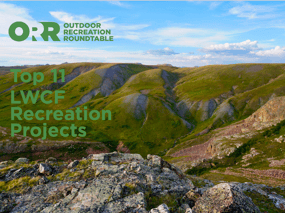 With the passage of the Great American Outdoors Act (GAOA), the Land and Water Conservation Fund (LWCF) now has a guaranteed source for $900 million in mandatory annual funding for outdoor recreation and conservation projects across the nation. That’s great news, but it also raises big questions about the best way to invest those much-needed funds.
With the passage of the Great American Outdoors Act (GAOA), the Land and Water Conservation Fund (LWCF) now has a guaranteed source for $900 million in mandatory annual funding for outdoor recreation and conservation projects across the nation. That’s great news, but it also raises big questions about the best way to invest those much-needed funds.
The Outdoor Recreation Roundtable (ORR) partnered with OREI here at Oregon State University to create a comprehensive list of projects in need of funding from LWCF. As part of that work, we’ve identified 11 projects that stand out for their ability to make the outdoors more inviting and accessible in the years to come.
The passing of the GAOA in July was one of the bright spots in what will long be remembered as an exceptionally dark year. Not only did GAOA represent a rare moment of bipartisan cooperation, it also signaled the start of a new era of financial stability for the Land and Water Conservation Fund (LWCF) and the promise of progress on a massive backlog of investment in conservation and recreation sites nationwide.
The question now is how to most effectively deploy those funds in a way that will deliver the best return on investment, in terms of conservation outcomes, rural economic development goals, and increased equitable access to parks and green spaces.
To help answer that question, ORR tapped OSU’s Outdoor Recreation Economy Initiative to build a comprehensive list of projects in need of funding from LWCF. Led by Ashley Lowe Mackenzie, a doctoral candidate in Applied Economics at Oregon State University, our team surveyed outdoor recreation partners from around the country—including state Outdoor Recreation Directors, outdoor businesses and user groups. Based on over 200 responses, we developed a database of projects, broken down by region, project type, communities served and more.
You can view the database here.
Of the projects reviewed, 11 particularly outstanding projects—in both backcountry and community settings—stood out for their potential to increase recreation access for diverse user groups and promote rural economic development by adding value to nearby communities. These projects will also create access for underrepresented groups (e.g. Black, Indigenous, and Persons of Color, Low-income, Disabled, Immigrants, etc.).
The Outdoor Recreation Roundtable’s Top 11 LCWF Projects are
- Homestead Climbing Area (Gila County, Arizona)
- Capturing a narrow window of opportunity, Access Fund secured temporary ownership of a critical access point to The Homestead in central Arizona to save the area from indefinite closure. With over 250 sport climbs on 12 limestone walls, The Homestead is one of the best winter limestone climbing areas in the country, boasting true “tufa” sport routes.
- Fishing Pier, Branch Channel of the C&D Canal (Delaware City, Delaware)
- This shovel-ready project stalled after funding fell through several years ago. A multi-use fishing and wildlife viewing platform would serve multiple communities in Delaware City and tie-in with existing trails while helping to restore the historic canal towpath.
- ATV/Snowmobile Trail from Dollar Bay to Lake Linden (Houghton County, MI)
- The proposed project will repair and replace culverts and rebuild the trail where washouts occurred on the Lake Linden Trail between Hubbell and Lake Linden. The Lake Linden trail is a multi-use recreational trail that was severely damaged in 2018 as a result of a 500 year storm and serves as an important link for not only recreation but also alternative transportation between communities in the Keweenaw Peninsula.
- All Abilities Park (Farmington, New Mexico)
- This new play facility is designed to meet the needs of all people, especially children who are not well served by typical parks and playgrounds, creating more and better opportunities for everyone to enjoy time outdoors.
- Bluewater Creek Area of Critical Environmental Concern (Cibola County, New Mexico)
- LWCF funds would help acquire private lands in and adjacent to BLM-managed public lands at Bluewater Creek ACEC (BLM Las Cruces Unit). This project has support from groups including the BLM Interdisciplinary team, Back Country Horsemen, Rocky Mountain Youth Corps, Cottonwood Gulch Expeditions, and New Mexico Volunteers for the Outdoors.
- Bryson Park District, Eastview and Westview Parks (Mercer County, Ohio).
- LWCF funding would help improve a cluster of parks in Mercer County, including shelter houses, kayak and canoe launch pads within the Bryson Park District, playground equipment, shelter houses and skate park improvements at Westview Park, and playground improvements, disc golf, pickleball courts and basketball courts at Eastview Park.
- Junction City Fishing (Lane County, Oregon)
- This will be a large project including 5 cantilever platforms, picnic tables and cover, benches, walkway over the wetlands section, a trail system around the pond, and paved sections of the most used sections of the pond. There will also be work to restore habitats damaged by current use and improve habitat around the pond.
- Yellowjacket Reservoir Access (John Day, Oregon)
- This project will consist of development of an access road, parking lot, and fishing dock system at the Yellowjacket Reservoir. The site currently has no facilities except a rough unimproved dirt road, so an all-new road and parking lot are needed at the site. In addition, an ADA fishing dock will be added in order to get anglers out past the vegetation in the reservoir.
- North Delaware River Greenway (Philadelphia, Pennsylvania)
- LWCF funding would help create an 11-mile network of parks, boat launches, and trails on the Northern Delaware River in Philadelphia. This project aligns with the PA plan by creating healthy access to walking and biking networks that are close to home; providing opportunities for everyone to regularly engage in outdoor recreation for under-served low-income communities; addressing infrastructure and maintenance needs in existing outdoor recreation areas; and fostering stewardship of our natural resources.
- Renovating Lakeside Park (Chelan County, Washington)
- LWCF funding would help renovate Lakeside Park. This heavily used park provides significant public access to Lake Chelan. The goals of the renovation are to expand capacity, improve accessibility, and increase recreational opportunities.
- Developing the Cap Sante Marina RV Park (Port of Anacortes, Washington)
- The Port of Anacortes will use this grant to develop an RV park in the Cap Sante Marina, transforming an existing gravel lot into an expanded facility with hedges for privacy and utility hook-ups that will eliminate the reliance on generators and reduce noise and air pollution.



